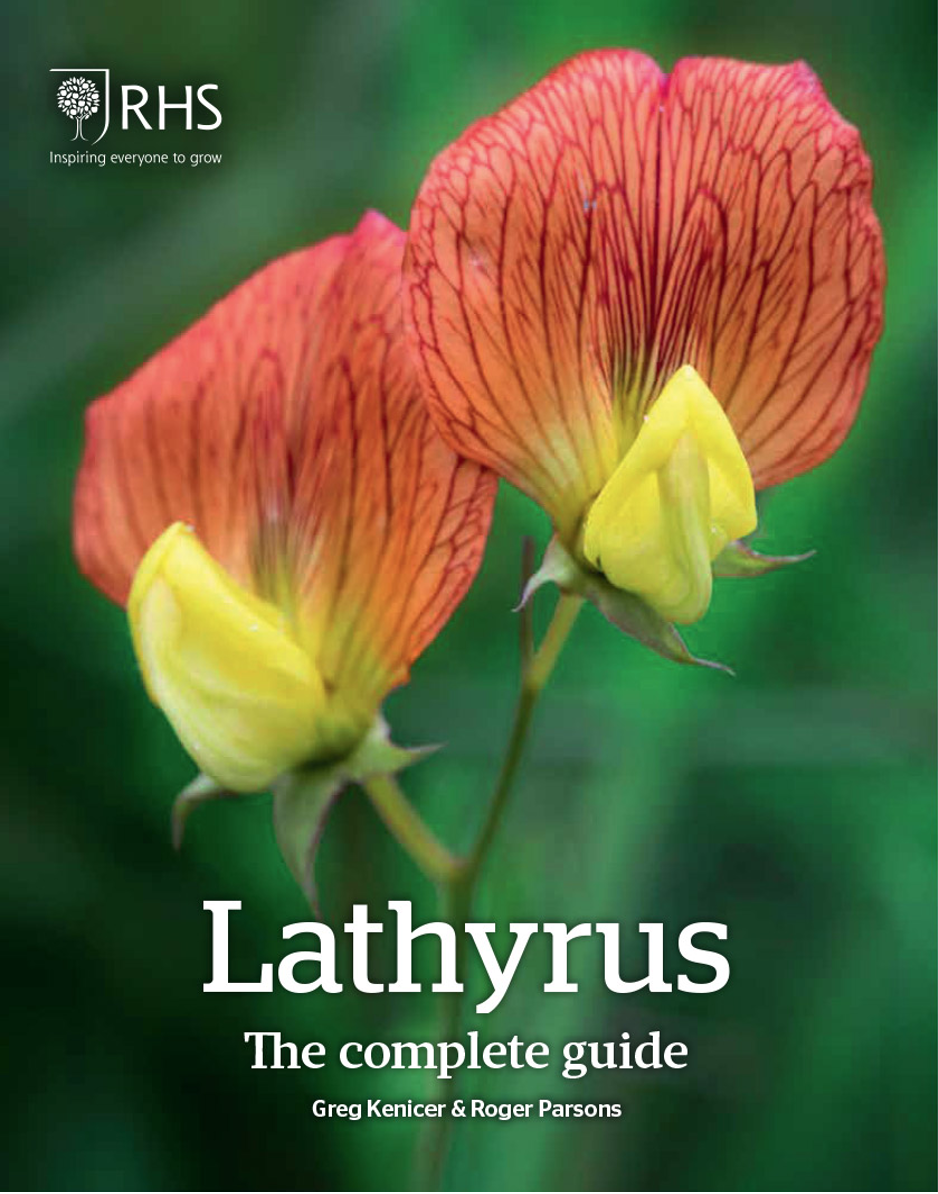Lathyrus: A Horticultural Monograph
Reviewed by Colin Hughes, University of Zürich, Switzerland

The genus Lathyrus, the archetypal pea of the pea family, has a new taxonomic monograph published in 2021. This is the fifth in the acclaimed series of Royal Horticultural Society (U.K.) Horticultural Monographs, and the second focusing on a legume genus, with a previous volume on Wisteria. As a horticultural monograph, it presents a fusion of botanical and science-based horticultural knowledge in a single volume. This fusion has been melded by the partnership of Greg Kenicer, a taxonomist based at the Royal Botanic Garden, Edinburgh, and Roger Parsons a horticulturalist and plantsman who has dedicated his life to growing, selecting, and curating varieties of one species of Lathyrus, the sweet pea, Lathyrus odoratus.
In addition to a taxonomic account of the 150 wild species of Lathyrus, 95 of them illustrated with photographs, the monograph also includes a detailed account of the numerous cultivated varieties of this one species, L. odoratus, one of the most treasured garden plants of temperate regions. Sweet peas are grown for their prolific, delightfully scented flowers produced in pastel, as well as more vibrant colours, from pure white to every possible shade of pink, lavender, purple, maroon, crimson and red. 1200 named horticultural varieties are listed in this book, their names resembling a colour chart for paints – Apricot Queen, Beaujolais, Blue Danube, Bouquet Pink, Little Red Riding Hood, Orange Dragon, Pink Cupid, Purple Prince, White Supreme, White Gem, and many more. 550 cultivars are illustrated with photographs, presenting a lavish and ravishing display of the diversity of flower colours, dispositions and petal shapes which vary in all manner of subtle ways only identifiable by a handful of sweet pea experts. Harnessing this diversity has been the product of decades of selection, breeding and propagation.
This work has been carried out by a small set of dedicated growers, plantsmen, seedsmen, and hobbyists, many of them sweet pea afficionados and fanatics. They established a veritable sweet pea cottage industry which blossomed initially in the U.K. fuelled by the quintessentially British gardening traditions of flower shows, competitions, National Plant Collections, specialist plant nurseries and the National Sweet Pea Society. This passion for sweet peas and selecting new varieties later spread to North America, Australia, New Zealand, Chile, and Japan. All this history and diversity is amply documented in this monograph.
With this strong focus on flowers and their extravagant colour variation, it would be easy to overlook the many other striking aspects of Lathyrus diversity. The leaves, stipules and tendrils of Lathyrus species are also extremely labile, including varieties where the leaflets have been replaced by tendrils forming aphyllous leaves that are completely tendrilous and support the plant in a tangled mass, while in L. aphaca where leaflets are also absent and reduced to tendrils, the expanded sagittate stipules take over the photosynthetic function. The diversity of habitats and environments where wild Lathyrus species occur is equally impressive and amply documented in this monograph with detailed notes on habitats and distributions.
Even with such a large chunk of this monograph devoted to just this one species, L. odoratus, there is, nevertheless, still plenty of space assigned to documenting the history and domestication of the other economically important species, including L. sativus, the grass pea, an important Neolithic food plant from the Middle East, L. cicera, the red-flowered chickling vetch, another food plant used in early times, and L. tuberosus which has edible tubers. None of these of course match the garden pea in terms of economic importance. While the garden pea has generally been known by the name Pisum sativum, it is now clear that the genera Pisum and Vavilovia are phylogenetically nested within Lathyrus1, and the authors of the Lathyrus monograph have bitten the bullet to treat these two genera as synonyms of Lathyrus. Thus, Pisum sativum is now Lathyrus oleraceus, a change that may be hard to swallow for breeders, geneticists and agronomists working with peas and the associated vast literature on Pisum that stretches back to Gregor Mendel’s pioneering experiments. Time will tell if this new synonymy becomes widely accepted or not.
This is a magnificent monograph, richly filled with keys, descriptions, notes and photographs, and an excellent template for other legume genera of horticultural importance.

1Schaefer H, Hechenleitner P, Santos-Guerra A, de Sequeira MM, Pennington RT, Kenicer G, Carine MA (2012). Systematics, biogeography, and character evolution of the legume tribe Fabeae with special focus on the middle- Atlantic island lineages. BMC Evolutionary Biology, 12: 250. https://doi.org/10.1186/1471-2148-12-250
Roger Parsons owns a Lathyrus nursery, Roger Parsons Sweet Peas, in the U.K., where he holds a National Plant Collection of the genus. He is the author of Sweet Peas: An Essential Guide (2011) and was Chairman of the U.K. National Sweet Pea Society from 2017 to 2020.
Greg Kenicer works at Royal Botanic Garden Edinburgh (RBGE) and is a specialist in wild Lathyrus diversity. He did a PhD on the South American species and, with international collaborators, has studied the biogeography, evolution, and taxonomy of Lathyrus. He also curates a second National Plant Collection of the genus held at RBGE.
https://www.summerfieldbooks.com/product/lathyrus-the-complete-guide/